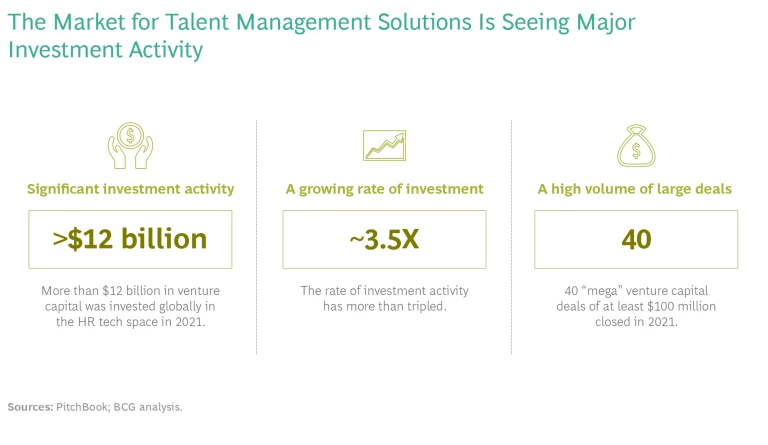A flood of new solutions is vying to help companies manage their workforce. In this crowded market, players can pursue three strategies to win share.
Talent management is a large and growing challenge at many organizations, and talent management providers are racing to roll out new offerings that can help business leaders and managers improve how they recruit, oversee, develop, and retain human capital. Many HR tech companies that formerly specialized in a single aspect of the talent management value chain are building out more comprehensive offerings, and others are growing through consolidation. Dozens of companies are competing to expand their offerings, causing significant confusion in the market.
HCM tech companies can focus on data, taxonomies, and connecting or orchestrating the value chain.
To create clarity for solution providers, we recently surveyed more than 100 CHROs and other business leaders to understand their current pain points and unmet needs in human capital management (HCM) technology. For technology providers and the investors that back them, the results offer real insights into what businesses want. We have also identified several ways that HCM technology companies can create advantage by focusing on differentiated data, skill taxonomies, and a position that connects or orchestrates multiple parts of the talent value chain.
The next 18 to 24 months will be a critical window for providers to stake out their positions in this crowded and highly active market. Those that understand the needs of the market and design smarter solutions to meet those needs will find the odds in their favor.
An Explosion in Activity
The past few years have seen an explosion in activity for talent management technologies. Companies are wrestling with the growing challenge of managing talent amid changes in work norms due to COVID, the gig economy, and other factors. But this challenge brings opportunity, too. In 2021, more than $12 billion in venture capital poured into the HR technology market, with the rate of investment more than tripling from 2020 to 2021, as investors back companies whose ideas are promising. (See the exhibit.)
BCG breaks the talent management value chain into six steps, with specific providers specializing in each:
- Anticipate future talent needs. Labor market analytics solutions like Emsi Burning Glass offer rich data about talent supply and demand at the skill level to inform workforce planning.
- Assess skill levels. Companies including EmPath and SkyHive use AI-powered solutions to assess and infer skills and proficiency levels in a more robust manner and at scale.
- Source talent and match internal candidates to opportunities. In addition to continued innovations in recruiting technology (such as HireVue’s video interviews and chat-based candidate interactions), we have seen new digital sourcing platforms like Catalant, InnoCentive, Toptal, and Upwork emerge to offer access to highly skilled labor “on demand.” Talent marketplaces provided by companies such as Gloat, Hitch, Fuel50, and Eightfold AI are emerging to better identify and manage internal talent and enable employees to move throughout the organization.
- Develop the skills and capabilities of the current workforce. A growing suite of learning and development companies like Degreed, EdCast, and BetterUp enable reskilling and upskilling and help managers identify internal candidates for specific roles.
- Embed workers in the organization. Solutions like Starmind and Microsoft Viva Topics promise to help workers navigate the organization and quickly get up to speed.
- Manage employee performance and engagement. Companies like Lattice and 15Five offer continuous performance management solutions with integrated performance appraisals, goal setting, and real-time feedback. Other competitors, including Perceptyx, help employers keep a pulse on employee sentiment through surveys and sensing and by crowdsourcing solutions.
Enterprise Customers Want an Integrated Solution
Despite all the activity, in many ways the field is still evolving and maturing. For example, skill taxonomies are of mixed quality and do not always align with each other, requiring significant adaptation to specific industries and individual companies. Solutions still have only a limited ability to accurately infer employee skill levels, and even sophisticated matching platforms rely almost exclusively on skills to create matches; they don’t consider factors like personalities or work preferences that we know are important in building teams. And applications that rely on analytics need to build controls to identify and dismantle bias—rather than amplifying it as some early-stage use cases have done.
More broadly, companies struggle to keep up with the variety of disconnected solutions for individual aspects of the value chain. That has led to a kind of arms race in the industry, as providers that are strong in one area of the value chain seek to address other areas. For example, Microsoft announced a partnership in early 2020 with Oracle to track job applicants more effectively by integrating LinkedIn employee profile data with the Microsoft Viva platform. Similarly, staffing agency Randstad launched a new offering in June 2021, called RiseSmart BrightFit, which combines labor market data with skill assessments to recommend roles and courses for transitioning employees on the basis of skill gaps and proficiency levels.
Other companies are building out their offerings through acquisition. For example, Workday made several acquisitions to expand its offerings, including Peakon ($700 million), which offers a tool to measure employee sentiment and engagement. That follows a bigger deal in 2018, for enterprise performance management platform Adaptive Insights ($1.6 billion).
In the short term, there is significant confusion in the market.
Over the long term, these innovations and investments will transform how companies manage talent, creating more equitable opportunities and unlocking fluid talent to meet some of their most pressing challenges. In the short term, however, there is significant confusion in the market. HCM software players, traditional staffing companies, strategic advisory firms, HR tech disruptors, and big tech are all playing in the space, looking to establish a favorable position as the ecosystem matures. To enterprise customers, it can seem as if everyone is trying to do everything, and there’s no clear winner just yet. According to one survey, a staggering 94% of HR decision makers struggle to keep up with the latest technology trends and developments.
This confusion comes through clearly in BCG’s survey results as well. We asked more than a hundred HR and business leaders for their thoughts about HCM technology and their most pressing pain points. Among the most important:
- Managing multiple sourcing functions, which leads to significant complexity
- Planning processes that fail to identify the skills needed to meet future business requirements
- Coordinating the ecosystem of various upskilling and reskilling providers or solutions
Our conversations with HR leaders suggest that the most important coordination needs to happen across the value chain, as companies look for solutions that integrate disparate data sources, talent sources, and functionality to manage talent more seamlessly.
Three Strategies for Talent Management Providers to Create an Edge
To create advantage in the fast-moving HR tech market, our analysis suggests three main strategies that talent management providers can apply to create a defensible advantage.
Develop differentiated data to power predictive analytics and insights. In a world powered by AI, data is king, and the scale, richness, differentiation, timeliness, and quality of the data all matter. Accurately identifying skill requirements and assessing capabilities requires working with macroeconomic data, job postings, résumé and career histories, candidate profiles, the hiring pipeline, training records, performance data, and even “on the job activity”—for example, data about which programs and applications people use in their day-to-day work. Incumbent HCM players—which have entrenched systems and already serve as central HR data repositories for most companies—have a strong position from which to expand and capture more value. Staffing companies have proprietary data derived from their activities—information about who needed what in terms of staff and when, how that staff performed, and how that staff was paid—that they can use to predict future talent needs and improve candidate matching, creating a positive feedback loop.
Another control point for data are talent marketplaces, which have an advantage because they actually create data through transactions. Learning platforms know who is learning what and how well individuals are mastering new skills, so these platforms can offer in-depth data on skills to aid matching. Finally, access to tools and applications that workers use in their day-to-day jobs can serve as a control point to yield richer data than external scraping alone. For example, Microsoft Viva Topics uses AI to determine topic expertise in an organization by scanning employees’ documents and emails.
Create a strong skill taxonomy, with the capability to adapt it for industry and company context. Almost every talent platform and external data provider has its own skill taxonomy or ontology to enable talent matching, but some are better than others. In our work with clients, we have found that most companies will need to invest in making their skill taxonomies fit for purpose (even those that are based on troves of data). Developing usable taxonomies can require aligning them with multiple external taxonomies, simplifying them using machine learning, and refining them further with functional and industry experts to unearth the common skills at the right level of granularity. For global organizations, this process also requires understanding the way that languages can have different terms for similar types of skills. And skill taxonomies aren’t static—they need to evolve over time as needed skillsets change more quickly than ever before.
Establish a position that connects or orchestrates multiple parts of the talent management value chain. Companies are eager for more-integrated solutions. An offering that first helps companies anticipate workforce needs and identify potential matches from across internal and external talent sources and then connects them with a set of reskilling and upskilling solutions will quickly become “sticky” to customers. Establishing such a position does not require owning all of the solution components—indeed, our research suggests that companies overwhelmingly want to be able to access a suite of upskilling providers rather than operating in a closed ecosystem. But companies that establish a position early in key points of the value chain—talent matching, for example, or even becoming the storefront for a variety of skilling activities—can create an advantage through strong customer relationships and by setting the terms of engagement for other ecosystem suppliers.
Implementation Must Go Beyond the Technology Itself
Last, the change management component of implementation is critical. Providers that treat talent management technology as a plug-and-play solution are setting themselves up for failure. Instead, BCG research has found that the real value of digital technology comes from realigning business processes and ways of working. A good rule of thumb is that 70% of the value comes from changes to the business, 20% from the technology itself, and 10% from the underlying algorithms. In fact, many enterprise companies looking at this market report that an intuitive user interface and a strong client success team are key considerations in their choice of solution partners .
But implementation needs go well beyond the technical domain. Companies also need partners that can work with them to adapt their skill taxonomies for industry and company specifications, help them learn from other companies’ journeys, and partner with them to envision their own future of work. More than any platform implementation, this journey is about changing an organization’s culture. Enterprise customers will flock to providers who can help them do just that.
The next 18 to 24 months will be a critical window of opportunity for talent management providers to stake out their positions, establish their role in emerging talent ecosystems, and claim share. Players and investors should keep a focus on enterprise customer needs and key control points and tailor their strategies accordingly.
The authors thank Sibley Lovett, Max Santinelli, JinK Koike, Andreas Liedtke, and Lena David for their thought partnership and contributions to this article.














